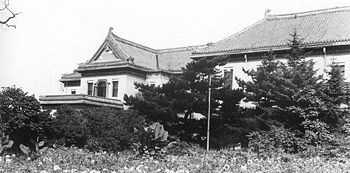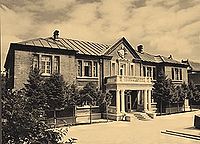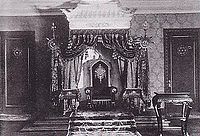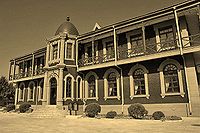
Museum of Imperial Palace of Manchu State
Encyclopedia
The Museum of the Imperial Palace of the Manchu State (Traditional Chinese: 偽滿皇宮博物院; Pinyin
: Wěi Mǎn Huánggōng Bówùyuàn, literally The Illegitimate Manchukuo Imperial Palace Museum) is a museum in the northeastern corner of Changchun
, Jilin
province, northeast China
. The Palace was the official residence created by the Imperial Japanese Army
for China's
last emperor Puyi
to live in as part of his role as Emperor
of the Japanese
puppet state
of Manchukuo
. In the People's Republic of China
the structures are generally referred to as the Puppet Emperor's Palace & Exhibition Hall.

from 1931 to 1945, the last emperor of the Qing dynasty
, Puyi
, was installed as the puppet leader of Manchukuo
. Puyi was a resident of Wei Huang Gong from 1932 to 1945. After the fall of Manchukuo, the palace was damaged when Soviet
troops looted Xinjing
. Afterwards, the structures were preserved and opened as the Museum of Imperial Palace of "Manchu State" (偽滿皇宮博物院) in 1962. The exhibits were expanded with that of the former Jilin Museum in 1982, and renovated in 1984. The entire complex was renovated in 2004.
The palace was the actual setting in Bernardo Bertolucci
's 1987 biographical film
of Puyi, The Last Emperor
, depicting Puyi's reign as Emperor of Manchukuo.
Palace was designed as a miniature version of the Forbidden City
in Beijing
. It was divided into an inner court and outer court. The outer or front court was used for administrative purposes and the inner or rear court as the royal residence. The palace covers an area of 43,000 square meters.
The inner court includes the private living quarters for Puyi and his family. Its main structures include Jixi Building on the west courtyard and Tongde Hall on the east courtyard. The outer court contained buildings for affairs of state. Its main buildings include Qianmin Building, Huanyuan Building and Jiale Hall. The architecture of the buildings is in a wide range of styles: Chinese, Japanese, and European.
Within the complex were gardens, including a rockeries and fish pond, a swimming pool
, air-raid shelter
, a tennis court
, a small golf course
and a horse track
.
Around the courtyards were nine two-storey blockhouses for the Manchukuo Imperial Guard, and the entire complex was surrounded by high concrete
walls.

chapel and the separate quarters for Empress Wan Rong
and the concubine Tan Yuling
. Originally it was the office building of the Jilin-Heilongjiang Exclusive Transportation Bureau, and was built in the early 1900s.
. The main hall was the setting for a dance party scene in the movie The Last Emperor
, although it was never actually used for that purpose.
 The imperial concubine Li Yuqin
The imperial concubine Li Yuqin
was housed in the east part of the second floor. The building today contains the Manchukuo Throne, various pieces of furniture, some replicas of the crown jewels
, flags, some dresses and uniforms, a copy of the Manchukuo declaration of independence, and other official items. High behind the throne is the national coat of arms
, with a five point star
, in different colors representing the five nationalities of Manchukuo: Manchu
(red
), Chinese
(yellow
), Mongol (blue
), Japanese
(white
) and Koreans (black
).
 Historical artifacts on display in the Qinmin Building include documents and photographs from Puyi's childhood to adulthood and wax figure
Historical artifacts on display in the Qinmin Building include documents and photographs from Puyi's childhood to adulthood and wax figure
s of Puyi with one of his wives. Additional exhibitions highlight war crime atrocities
from World War II
such as incidents related to the Unit 731
.
.
Pinyin
Pinyin is the official system to transcribe Chinese characters into the Roman alphabet in China, Malaysia, Singapore and Taiwan. It is also often used to teach Mandarin Chinese and spell Chinese names in foreign publications and used as an input method to enter Chinese characters into...
: Wěi Mǎn Huánggōng Bówùyuàn, literally The Illegitimate Manchukuo Imperial Palace Museum) is a museum in the northeastern corner of Changchun
Changchun
Changchun is the capital and largest city of Jilin province, located in the northeast of the People's Republic of China, in the center of the Songliao Plain. It is administered as a sub-provincial city with a population of 7,677,089 at the 2010 census under its jurisdiction, including counties and...
, Jilin
Jilin
Jilin , is a province of the People's Republic of China located in the northeastern part of the country. Jilin borders North Korea and Russia to the east, Heilongjiang to the north, Liaoning to the south, and Inner Mongolia to the west...
province, northeast China
Northeast China
Northeast China, historically known in English as Manchuria, is a geographical region of China, consisting of the three provinces of Liaoning, Jilin and Heilongjiang. The region is sometimes called the Three Northeast Provinces...
. The Palace was the official residence created by the Imperial Japanese Army
Imperial Japanese Army
-Foundation:During the Meiji Restoration, the military forces loyal to the Emperor were samurai drawn primarily from the loyalist feudal domains of Satsuma and Chōshū...
for China's
China
Chinese civilization may refer to:* China for more general discussion of the country.* Chinese culture* Greater China, the transnational community of ethnic Chinese.* History of China* Sinosphere, the area historically affected by Chinese culture...
last emperor Puyi
Puyi
Puyi , of the Manchu Aisin Gioro clan, was the last Emperor of China, and the twelfth and final ruler of the Qing Dynasty. He ruled as the Xuantong Emperor from 1908 until his abdication on 12 February 1912. From 1 to 12 July 1917 he was briefly restored to the throne as a nominal emperor by the...
to live in as part of his role as Emperor
Puppet ruler
A puppet ruler is a person who has a title indicating possession of political power, but who, in reality, is controlled by outside individuals or forces. Such outside power can be exercised by a foreign government, in which case the puppet ruler's domain is called a puppet state...
of the Japanese
Empire of Japan
The Empire of Japan is the name of the state of Japan that existed from the Meiji Restoration on 3 January 1868 to the enactment of the post-World War II Constitution of...
puppet state
Puppet state
A puppet state is a nominal sovereign of a state who is de facto controlled by a foreign power. The term refers to a government controlled by the government of another country like a puppeteer controls the strings of a marionette...
of Manchukuo
Manchukuo
Manchukuo or Manshū-koku was a puppet state in Manchuria and eastern Inner Mongolia, governed under a form of constitutional monarchy. The region was the historical homeland of the Manchus, who founded the Qing Empire in China...
. In the People's Republic of China
People's Republic of China
China , officially the People's Republic of China , is the most populous country in the world, with over 1.3 billion citizens. Located in East Asia, the country covers approximately 9.6 million square kilometres...
the structures are generally referred to as the Puppet Emperor's Palace & Exhibition Hall.

History
During the Japanese occupation of ManchuriaManchuria
Manchuria is a historical name given to a large geographic region in northeast Asia. Depending on the definition of its extent, Manchuria usually falls entirely within the People's Republic of China, or is sometimes divided between China and Russia. The region is commonly referred to as Northeast...
from 1931 to 1945, the last emperor of the Qing dynasty
Qing Dynasty
The Qing Dynasty was the last dynasty of China, ruling from 1644 to 1912 with a brief, abortive restoration in 1917. It was preceded by the Ming Dynasty and followed by the Republic of China....
, Puyi
Puyi
Puyi , of the Manchu Aisin Gioro clan, was the last Emperor of China, and the twelfth and final ruler of the Qing Dynasty. He ruled as the Xuantong Emperor from 1908 until his abdication on 12 February 1912. From 1 to 12 July 1917 he was briefly restored to the throne as a nominal emperor by the...
, was installed as the puppet leader of Manchukuo
Manchukuo
Manchukuo or Manshū-koku was a puppet state in Manchuria and eastern Inner Mongolia, governed under a form of constitutional monarchy. The region was the historical homeland of the Manchus, who founded the Qing Empire in China...
. Puyi was a resident of Wei Huang Gong from 1932 to 1945. After the fall of Manchukuo, the palace was damaged when Soviet
Red Army
The Workers' and Peasants' Red Army started out as the Soviet Union's revolutionary communist combat groups during the Russian Civil War of 1918-1922. It grew into the national army of the Soviet Union. By the 1930s the Red Army was among the largest armies in history.The "Red Army" name refers to...
troops looted Xinjing
Changchun
Changchun is the capital and largest city of Jilin province, located in the northeast of the People's Republic of China, in the center of the Songliao Plain. It is administered as a sub-provincial city with a population of 7,677,089 at the 2010 census under its jurisdiction, including counties and...
. Afterwards, the structures were preserved and opened as the Museum of Imperial Palace of "Manchu State" (偽滿皇宮博物院) in 1962. The exhibits were expanded with that of the former Jilin Museum in 1982, and renovated in 1984. The entire complex was renovated in 2004.
The palace was the actual setting in Bernardo Bertolucci
Bernardo Bertolucci
Bernardo Bertolucci is an Italian film director and screenwriter, whose films include The Conformist, Last Tango in Paris, 1900, The Last Emperor and The Dreamers...
's 1987 biographical film
Biographical film
A biographical film, or biopic , is a film that dramatizes the life of an actual person or people. They differ from films “based on a true story” or “historical films” in that they attempt to comprehensively tell a person’s life story or at least the most historically important years of their...
of Puyi, The Last Emperor
The Last Emperor
The Last Emperor is a 1987 biopic about the life of Puyi, the last Emperor of China, whose autobiography was the basis for the screenplay written by Mark Peploe and Bernardo Bertolucci. Independently produced by Jeremy Thomas, it was directed by Bertolucci and released in 1987 by Columbia Pictures...
, depicting Puyi's reign as Emperor of Manchukuo.
Structures
The Manchurian ImperialEmpire
The term empire derives from the Latin imperium . Politically, an empire is a geographically extensive group of states and peoples united and ruled either by a monarch or an oligarchy....
Palace was designed as a miniature version of the Forbidden City
Forbidden City
The Forbidden City was the Chinese imperial palace from the Ming Dynasty to the end of the Qing Dynasty. It is located in the middle of Beijing, China, and now houses the Palace Museum...
in Beijing
Beijing
Beijing , also known as Peking , is the capital of the People's Republic of China and one of the most populous cities in the world, with a population of 19,612,368 as of 2010. The city is the country's political, cultural, and educational center, and home to the headquarters for most of China's...
. It was divided into an inner court and outer court. The outer or front court was used for administrative purposes and the inner or rear court as the royal residence. The palace covers an area of 43,000 square meters.
The inner court includes the private living quarters for Puyi and his family. Its main structures include Jixi Building on the west courtyard and Tongde Hall on the east courtyard. The outer court contained buildings for affairs of state. Its main buildings include Qianmin Building, Huanyuan Building and Jiale Hall. The architecture of the buildings is in a wide range of styles: Chinese, Japanese, and European.
Within the complex were gardens, including a rockeries and fish pond, a swimming pool
Swimming pool
A swimming pool, swimming bath, wading pool, or simply a pool, is a container filled with water intended for swimming or water-based recreation. There are many standard sizes; the largest is the Olympic-size swimming pool...
, air-raid shelter
Air-raid shelter
Air-raid shelters, also known as bomb shelters, are structures for the protection of the civil population as well as military personnel against enemy attacks from the air...
, a tennis court
Tennis court
A tennis court is where the game of tennis is played. It is a firm rectangular surface with a low net stretched across the center. The same surface can be used to play both doubles and singles.-Dimensions:...
, a small golf course
Golf course
A golf course comprises a series of holes, each consisting of a teeing ground, fairway, rough and other hazards, and a green with a flagstick and cup, all designed for the game of golf. A standard round of golf consists of playing 18 holes, thus most golf courses have this number of holes...
and a horse track
Hippodrome
A hippodrome was a Greek stadium for horse racing and chariot racing. The name is derived from the Greek words "hippos and "dromos"...
.
Around the courtyards were nine two-storey blockhouses for the Manchukuo Imperial Guard, and the entire complex was surrounded by high concrete
Concrete
Concrete is a composite construction material, composed of cement and other cementitious materials such as fly ash and slag cement, aggregate , water and chemical admixtures.The word concrete comes from the Latin word...
walls.

Jixi Building
The Jixi Building was the Russian-style private living quarters for the Emperor and his immediate family. It contained Puyi's bedroom, reading room, the family hall, BuddhistBuddhism
Buddhism is a religion and philosophy encompassing a variety of traditions, beliefs and practices, largely based on teachings attributed to Siddhartha Gautama, commonly known as the Buddha . The Buddha lived and taught in the northeastern Indian subcontinent some time between the 6th and 4th...
chapel and the separate quarters for Empress Wan Rong
Wan Rong
Lady Gobulo, Empress Xiaokemin , better known as Empress Wanrong, was the Empress of Puyi, the last Emperor of China and final ruler of the Qing Dynasty. She became empress of the puppet state of Manchukuo when Puyi was declared emperor of that state by the Empire of Japan.-Early life and marriage...
and the concubine Tan Yuling
Tan Yuling
-External links:*...
. Originally it was the office building of the Jilin-Heilongjiang Exclusive Transportation Bureau, and was built in the early 1900s.
Tongde Hall
The Tongde Hall is the largest and most impressive of the buildings in the palace, and has the most luxurious interior decoration. Originally the Jilin Salt Tax Collection Office, and therefore sometimes referred to as the "Salt Palace", Japanese engineers remodeled it from 1936 to 1938. However, Puyi refused to use the building, as he believed it to be buggedCovert listening device
A covert listening device, more commonly known as a bug or a wire, is usually a combination of a miniature radio transmitter with a microphone. The use of bugs, called bugging, is a common technique in surveillance, espionage and in police investigations.A bug does not have to be a device...
. The main hall was the setting for a dance party scene in the movie The Last Emperor
The Last Emperor
The Last Emperor is a 1987 biopic about the life of Puyi, the last Emperor of China, whose autobiography was the basis for the screenplay written by Mark Peploe and Bernardo Bertolucci. Independently produced by Jeremy Thomas, it was directed by Bertolucci and released in 1987 by Columbia Pictures...
, although it was never actually used for that purpose.

Li Yuqin
Li Yuqin , also known as the "Last Imperial Concubine" , was the fourth wife and last Imperial Concubine of Puyi, the last Emperor of China's Qing Dynasty....
was housed in the east part of the second floor. The building today contains the Manchukuo Throne, various pieces of furniture, some replicas of the crown jewels
Crown jewels
Crown jewels are jewels or artifacts of the reigning royal family of their respective country. They belong to monarchs and are passed to the next sovereign to symbolize the right to rule. They may include crowns, sceptres, orbs, swords, rings, and other objects...
, flags, some dresses and uniforms, a copy of the Manchukuo declaration of independence, and other official items. High behind the throne is the national coat of arms
Coat of arms
A coat of arms is a unique heraldic design on a shield or escutcheon or on a surcoat or tabard used to cover and protect armour and to identify the wearer. Thus the term is often stated as "coat-armour", because it was anciently displayed on the front of a coat of cloth...
, with a five point star
Star
A star is a massive, luminous sphere of plasma held together by gravity. At the end of its lifetime, a star can also contain a proportion of degenerate matter. The nearest star to Earth is the Sun, which is the source of most of the energy on Earth...
, in different colors representing the five nationalities of Manchukuo: Manchu
Manchu
The Manchu people or Man are an ethnic minority of China who originated in Manchuria . During their rise in the 17th century, with the help of the Ming dynasty rebels , they came to power in China and founded the Qing Dynasty, which ruled China until the Xinhai Revolution of 1911, which...
(red
Red
Red is any of a number of similar colors evoked by light consisting predominantly of the longest wavelengths of light discernible by the human eye, in the wavelength range of roughly 630–740 nm. Longer wavelengths than this are called infrared , and cannot be seen by the naked eye...
), Chinese
Han Chinese
Han Chinese are an ethnic group native to China and are the largest single ethnic group in the world.Han Chinese constitute about 92% of the population of the People's Republic of China , 98% of the population of the Republic of China , 78% of the population of Singapore, and about 20% of the...
(yellow
Yellow
Yellow is the color evoked by light that stimulates both the L and M cone cells of the retina about equally, with no significant stimulation of the S cone cells. Light with a wavelength of 570–590 nm is yellow, as is light with a suitable mixture of red and green...
), Mongol (blue
Blue
Blue is a colour, the perception of which is evoked by light having a spectrum dominated by energy with a wavelength of roughly 440–490 nm. It is considered one of the additive primary colours. On the HSV Colour Wheel, the complement of blue is yellow; that is, a colour corresponding to an equal...
), Japanese
Japanese people
The are an ethnic group originating in the Japanese archipelago and are the predominant ethnic group of Japan. Worldwide, approximately 130 million people are of Japanese descent; of these, approximately 127 million are residents of Japan. People of Japanese ancestry who live in other countries...
(white
White
White is a color, the perception of which is evoked by light that stimulates all three types of color sensitive cone cells in the human eye in nearly equal amounts and with high brightness compared to the surroundings. A white visual stimulation will be void of hue and grayness.White light can be...
) and Koreans (black
Black
Black is the color of objects that do not emit or reflect light in any part of the visible spectrum; they absorb all such frequencies of light...
).
Qinmin Building
The Qinmin Building was Puyi's office building. In its southeast corner is a large room where Puyi received foreign ambassadors and consuls, and issued certificates of appointment and conferred medals to his government officials. The Qianmin Building housed the Manchukuo throne, which has now been moved to the Tongde Hall for the museum display.
Wax figure
A wax sculpture is a sculpture made in wax. Often these are effigies, usually of a notable individual, but there are also death masks and scenes with many figures, mostly in relief....
s of Puyi with one of his wives. Additional exhibitions highlight war crime atrocities
War crimes in Manchukuo
War crimes in Manchukuo were committed during the rule of the Empire of Japan in northeast China, either directly, or through its puppet state of Manchukuo, from 1931 to 1945...
from World War II
World War II
World War II, or the Second World War , was a global conflict lasting from 1939 to 1945, involving most of the world's nations—including all of the great powers—eventually forming two opposing military alliances: the Allies and the Axis...
such as incidents related to the Unit 731
Unit 731
was a covert biological and chemical warfare research and development unit of the Imperial Japanese Army that undertook lethal human experimentation during the Second Sino-Japanese War and World War II. It was responsible for some of the most notorious war crimes carried out by Japanese...
.
Zhixiu House
Zhixiu House was a detached structure built in the early 1930s. It was used as an informal dining hall by Emperor Puyi. A portion of Puyi's cash and jewels were kept in the two safes in the back apartment. After Puyi's second younger sister married Zheng Guangyuan, they lived here for a time. When the Tongde Building was completed, this structure was transformed into a school for the children of the palace employees.Changchun House
Changchun House was another detached structure designed as a mirror image of Zhixue House to maintain symmetry in the palace layout. At first the fourth and the fifth younger sisters of Puyi lived here. In July 1937 it was the residence for Puyi's father, Zaifeng, when he visited briefly to congratulate Puyi on becoming Emperor. Afterwards, the residence was used by the imperial concubine Tan YulingTan Yuling
-External links:*...
.

